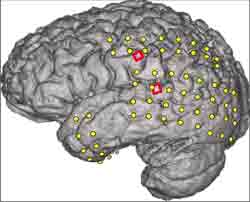The New Mind Readers: Electrodes Reach for Telepathy
Two kinds of electrodes sit atop a severely epileptic patient’s brain. The electrodes could play a significant role in helping locked-in syndrome patients to communicate.
September 23, 2010
Helping severely paralyzed people convey their wants and needs just got a little easier, thanks to experimental implants that could use brain signals to decode thoughts. Researchers from the University of Utah have invented two grids of 16 microelectrodes that are implanted between the skull and the brain. These implants could help people with locked-in syndrome, a condition in which a patient is aware and awake but cannot move or communicate due to complete paralysis of nearly all voluntary muscles in the body except for the eyes.
“We have been able to decode spoken words using only signals from the brain with a device that has promise for long-term use in paralyzed patients who cannot now speak,” says Bradley Greger, an assistant professor of bioengineering at the university and author of the study.
The University of Utah research team placed grids of tiny microelectrodes over speech centers in the brain of a volunteer with severe epileptic seizures. The man already had a craniotomy—temporary partial skull removal—so doctors could place larger, conventional electrodes to locate the source of his seizures and surgically stop them.
The study used a nonpenetrating microelectrode that sits on the brain rather than requiring invasive implantation. These electrodes are known as microECoGs because they are a small version of the much larger electrodes used for electrocorticography, or ECoG.
The scientists recorded brain signals as the patient repeatedly read 10 words that might be useful to a paralyzed person: yes, no, hot, cold, hungry, thirsty, hello, goodbye, more, and less. Analysis of the brain waves during such repetition helped distinguish waves generated during each word, with 28–48% accuracy. Such numbers are better than chance, but not good enough for accurate translations.
|
Magnetic resonance image (MRI) of an epileptic patient’s brain is superimposed with the locations of the electrodes used by University of Utah researchers. |
“This is proof of concept,” Greger says, “We’ve proven these signals can tell you what the person is saying well above chance. But we need to be able to do more words with more accuracy before it is something a patient really might find useful.”
Because the microelectrodes do not penetrate brain matter, they are considered safe to place on speech areas of the brain, which cannot be done with penetrating electrodes that have been used in experimental devices to help paralyzed people control a computer cursor or an artificial arm.
Greger says he expects several years of development before the device is ready for clinical trials. Eventually, a wireless computer system that translates brain signals could prove useful to people with stroke, amyotrophic lateral sclerosis, or trauma.
“The obvious next step—and this is what we are doing right now—is to do it with bigger microelectrode grids” with 121 microelectrodes in an 11 × 11 grid, he says. “We can make the grid bigger, have more electrodes and get a tremendous amount of data out of the brain, which probably means more words and better accuracy.”
Greger’s study is featured in the September issue of the Journal of Neural Engineering. The research was funded by the National Institutes of Health, the Defense Advanced Research Projects Agency, the University of Utah Research Foundation, and the National Science Foundation
About the Author(s)
You May Also Like


.png?width=300&auto=webp&quality=80&disable=upscale)
